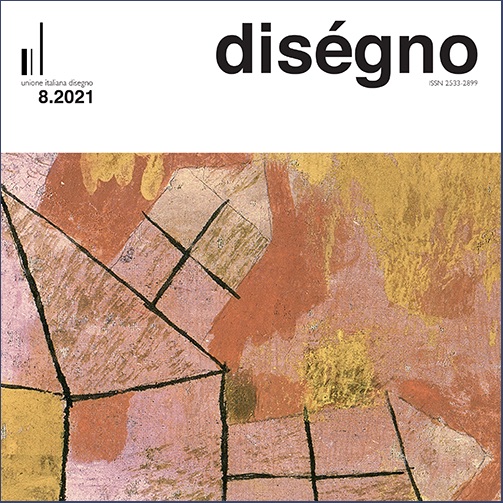Rappresentazioni di città. Il Museo Diffuso The Esquilino Tales
DOI:
https://doi.org/10.26375/disegno.8.2021.19Parole chiave:
linguaggi grafici, comunicare, valorizzare, gamification, storytellingAbstract
Di recente nell’ambito valorizzazione e dell’educazione al patrimonio culturale diverse sperimentazioni sono state indirizzate verso la definizione di nuovi paradigmi esperienziali, rimettendo al centro le azioni e le interazioni dei e tra i soggetti coinvolti. Si è così rinnovato l’interesse per quelle esperienze capaci di integrare educazione e divertimento, perché l’ambiente emozionale del gioco e il metodo “imparare facendo” facilita i processi di apprendimento. In questo contesto è presentata l’esperienza The Esquilino Tales, condotta nel Master in Comunicazione dei Beni Culturali della Sapienza Università di Roma, che si è proposta di valorizzare la complessità molteplice, eppure identitaria, dell’Esquilino, XV Rione di Roma. Trattandosi di un Bene in cui sia l’insieme e sia le singole sue parti sono innanzitutto riconoscibili in quanto “figure”, si è partiti dal convincimento che una proposta efficace non potesse che muovere dalla specificità segnica dei luoghi. La sperimentazione ha perciò approfondito le pratiche della Rappresentazione, innovandole attraverso le tecniche dello storytelling, della gamification e dello storydoing, con l’obiettivo di mettere a punto, all’interno di un’ampia gamma di linguaggi grafico-visuali, una strategia di comunicazione. Strategia che si è proposta di attivare tra i visitatori/cittadini e Esquilino/città modalità attive di esplorazione quali prime azioni di valorizzazione e di rigenerazione urbana da cui partire per il riscatto delle nostre città.
Riferimenti bibliografici
Albisinni, P., Ippoliti, E. (a cura di). (2016). Virtual Museums of Architecture and City. DisegnareCon, 9(17).
Asproni, P. (2018). Musei: trasformazioni e prospettive. In Il Giornale delle Fondazioni. Museo Quo Vadis?. <http://www.ilgiornaledellefondazioni.com/content/musei-trasformazioni-e-prospettive> (accessed 2021, March 10).
Baricco, A. (2018). The Game. Torino: Einaudi.
Bray, M. (2013). Il turismo e l’incontro tra beni culturali e territorio. <http://www.massimobray.it/il-turismo-e-lincontro-tra-beni-culturali-e-territorio/> (accessed 2021, March 10).
Bruno, G. (2006). Atlante delle emozioni: in viaggio tra arte architettura e cinema. Milano: Bruno Mondadori.
Cameron, D. F. (1968). A viewpoint: The Museum as a communication system and implications for museum education. In Curator. The Museum Journal, 11(1), pp. 33-40.
Cingano, F., Cipollone, P. (2009). I rendimenti dell’istruzione (The private and social return to schooling in Italy). (Occasional Papers), 53, pp. 1-27. <https://www.bancaditalia.it/pubblicazioni/qef/2009-0053/index.html> (accessed 2021, March 10).
Corbisiero, F., Berritto A. (2017). I bambini inventano la città: partecipare per progettare. In La città creativa. Spazi pubblici e luoghi della quotidianità. CNAPPC Consiglio Nazionale Architetti Pianificatori Paesaggisti e Conservatori, pp. 263-270. <http://www.cittacreative.eu/wp-content/uploads/2017/04/La_citt%C3%A0_creativa_2017.pdf> (accessed 2021, March 10).
Desvallées, A., Mairesse, F. (a cura di). (2016). Concetti chiave di museologia. Parigi: A. Colin. International Council of Museums.
Eco, U. (1973). Homo Ludens Oggi. In J. Huizinga. Homo Ludens, pp. VII-XXVII. Torino: Einaudi.
Eco, U. (1991). Lector in fabula: la cooperazione interpretativa nei testi narrativi. Milano: Bompiani.
Gariboldi, A. (2017). La rivoluzione copernicana dei pubblici. In Il Giornale delle Fondazioni. Studi e ricerche <http://www.ilgiornaledellefondazioni.com/content/la-rivoluzione-copernicana-dei-pubblici> (accessed 2021, March 10).
Huizinga, J. (1949). Homo Ludens. A study of the Play-Element in Culture. London: Routledge and Kegan Paul Ltd.
Lampis, A. (2018). I videogiochi per conoscere arte e cultura. In Economia della Cultura, Rivista trimestrale dell’Associazione per l’Economia della Cultura. 3/2018, pp. 269-274.
Lasswell, H. D. (1948). The structure and function of communication in society. In L. Bryson (ed. ). The communication of ideas, pp. 37-52. New York: Institute for Religious and Social Studies, Harper & Brothers.
Lugli, A. (1993). Museologia. In A. Conti, R. Cassanelli (a cura di). L’arte. Critica e conservazione, pp. 75-100. Milano: Jaca book.
Luigini, A., Panciroli, C. (a cura di). (2018). Ambienti digitali per l’educazione all’arte e al patrimonio. Milano: FrancoAngeli.
Mangani, G. (2007). Introduzione alla riedizione del Teatro del mondo di Abramo Ortelio (Venezia 1724). In L’Universo, a. LXXXVII, n. 6, 2007, supplemento <http://nuke.giorgiomangani.it/Portals/0/GiorgioMangani/downloads/Introduzione%20a%20Teatro%20del%20mondo%202007.pdf> (accessed 2021, March 10).
MiBACT (2014). Organizzazione e funzionamento dei musei statali, Decreto 23 dicembre 2014 (Decreto Musei). <http://musei.beniculturali.it/wp-content/uploads/2018/04/Decreto-Ministeriale-23-12-2014-agg.-02-2018-ECA.pdf> (accessed 2021, March 10).
Mottola Molfino, A. (2007). Museo (lemma). In Treccani, Enciclopedia Italiana. VII Appendice <http://www.treccani.it/enciclopedia/museo_res-81d75601-9bc2-11e2-9d1b-00271042e8d9_(Enciclopedia-Italiana)/> (accessed 2021, March 10).
Paglieri, F. (2002). Credendo di giocare. Verso un’interpretazione cognitivista dei processi ludici. In Sistemi intelligenti, 14 (3), pp. 371-415.
Pescarin, S. (a cura di). (2020). Videogames, Ricerca, Patrimonio Culturale. Milano: FrancoAngeli.
Pomian, K. (1987). Collectionneurs, amateurs et curieux. Paris, Venise: XVIe-XVIIIe siècle. Paris: Gallimard.
Ragonese, R. (2010). Guide turistiche: un’introduzione. In E|C Serie Speciale. Journal online of AISS - Associazione Italiana di Studi Semiotici, anno V, n. 6, pp. 5-18.
Rogers, F., Sharapan H. B., (1994). How children use play. In Education Digest, 59(8), pp. 13-16.
Settis, S. (2002). Italia S.p.A. L’assalto al patrimonio culturale. Torino: Einaudi.
Settis, S. (2017). Un confronto tra Geburtstagsatlas e Mnemosyne Atlas: Tavola 7*. In Settis S., Pedersoli A., Culotta S., Esercizi di confronto tra le Tavole 7, 30, 37 del Geburtstagsatlas di Gombrich e le corrispondenti del Mnemosyne Atlas, La Rivista di Engramma, 151/2017, pp. 96-100.
UNESCO (2003). Convention for the Safeguarding of the Intangible Cultural Heritage <https://ich.unesco.org/en/convention> (accessed 2021, March 10).
UNESCO (2015). Recommendation concerning the Protection and Promotion of Museums and Collections, their Diversity and their Role in Society <http://umac.icom.museum/wp-content/uploads/2018/08/246331m.pdf> (accessed 2021, March 10).
Viola, F., Idone Cassone, V. (2017). L’arte del coinvolgimento. Emozioni e stimoli per cambiare il mondo. Milano: Hoepli.
##submission.downloads##
Pubblicato
Come citare
Fascicolo
Sezione
Licenza
Copyright (c) 2021 diségno

TQuesto lavoro è fornito con la licenza Creative Commons Attribuzione 4.0 Internazionale.






